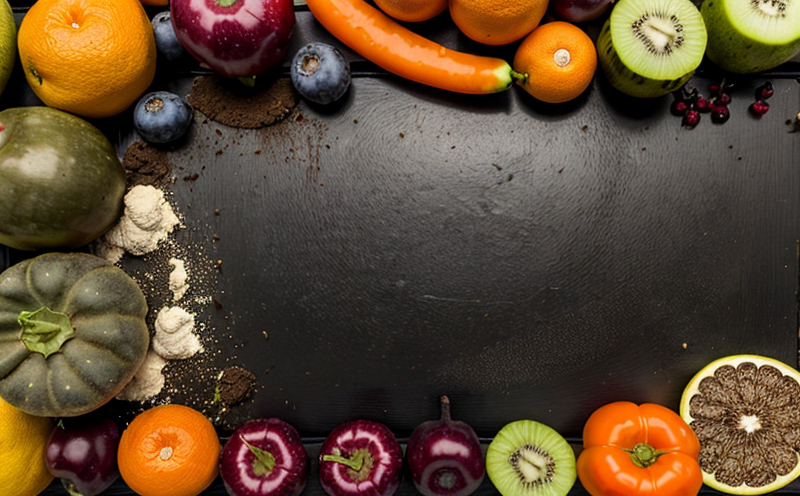AOAC 2006.08 Cadmium Residue Testing in Fruits
The AOAC International Method 2006.08 is a widely recognized standard for the determination of cadmium residue levels in various food and feed products, including fruits. This method provides a reliable and accurate procedure to ensure compliance with international standards for food safety and quality assurance.
Cadmium is a heavy metal that can be harmful to human health when present in high concentrations. The World Health Organization (WHO) recommends strict limits on cadmium content in foods, particularly those consumed by infants and children. This makes the AOAC 2006.08 method an essential tool for quality managers, compliance officers, R&D engineers, and procurement professionals who need to ensure that their products meet these stringent requirements.
The testing process involves several key steps. First, a representative sample of the fruit is collected from its intended source. This ensures that the test results are reflective of the actual product quality. The sample is then prepared according to specific guidelines provided in the AOAC method. Proper preparation is crucial as it directly affects the accuracy and reliability of the final test result.
Following preparation, the sample undergoes digestion using a suitable acid mixture, typically nitric acid. This step aims to convert cadmium into its ionic form for easier detection. After digestion, the solution containing the dissolved cadmium is analyzed using inductively coupled plasma mass spectrometry (ICP-MS). ICP-MS provides highly sensitive and precise measurements of trace elements like cadmium.
The method specifies a detection limit of 0.1 parts per million (ppm) for cadmium, which aligns with the WHO's recommended maximum limits. This sensitivity ensures that even minute amounts of cadmium can be detected, thus protecting consumer health and ensuring product safety.
It is important to note that the AOAC 2006.08 method does not just provide a numerical result; it also offers valuable insights into the overall quality of the fruit being tested. By identifying even trace amounts of cadmium, this method helps in maintaining high standards of food safety and quality.
Quality managers can use the results from AOAC 2006.08 to make informed decisions about product sourcing, processing methods, and distribution practices. Compliance officers will find it useful for ensuring that their products meet regulatory requirements set by organizations like the European Union and the United States Food and Drug Administration (FDA).
R&D engineers can leverage this testing method to innovate new processes or formulations that reduce cadmium contamination while maintaining product quality. Procurement professionals benefit from knowing which suppliers adhere to stringent safety standards, thereby reducing risks associated with contaminated goods.
Industry Applications
The AOAC 2006.08 method finds extensive application across multiple industries where food and feed products are involved. Agriculture and horticulture sectors rely heavily on this test to monitor cadmium levels in various fruit types, ensuring that they meet global safety standards.
Food processing companies use the AOAC 2006.08 method to verify the quality of raw materials before they enter their production lines. This helps prevent the introduction of contaminants into finished products and enhances consumer confidence. Similarly, in the pharmaceutical industry, fruits used as ingredients must be free from cadmium contamination to comply with stringent regulatory requirements.
Importantly, this method also supports traceability efforts by providing a consistent benchmark for measuring cadmium levels across different batches and suppliers. This ensures that consumers receive products that are not only safe but also consistently high in quality.
Competitive Advantage and Market Impact
Implementing the AOAC 2006.08 method can significantly enhance a company's competitive position within the market. By demonstrating a commitment to food safety and quality, businesses gain consumer trust and loyalty. This is particularly crucial in today’s highly competitive global marketplace where product recalls due to contamination can have severe financial implications.
Compliance with international standards like AOAC 2006.08 also opens up new market opportunities by allowing companies to access export markets that require stringent safety regulations. For instance, the European Union has strict limits on cadmium in food products, and being able to demonstrate compliance through rigorous testing can help break into these lucrative markets.
In addition, adopting advanced testing methods like AOAC 2006.08 can position a company as a leader in innovation within its sector. This not only enhances brand reputation but also fosters long-term relationships with reliable suppliers and customers.
Use Cases and Application Examples
In practice, the AOAC 2006.08 method is applied in various scenarios to ensure food safety and quality. For example, a fruit juice manufacturer might use this test to monitor cadmium levels in apples before they are processed into juice. Similarly, a supermarket chain could employ this method during routine inspections of its suppliers to guarantee that the fruits it sells meet all necessary safety standards.
Another practical application is in research and development projects aimed at improving fruit quality or finding alternative methods for reducing cadmium contamination. By using AOAC 2006.08, researchers can accurately measure changes in cadmium levels as they experiment with new growing techniques or soil treatments.
A case study involving a large-scale fruit processor highlighted the importance of this method. After implementing AOAC 2006.08, the company was able to identify and eliminate sources of cadmium contamination in its supply chain, leading to improved product quality and enhanced consumer satisfaction.





